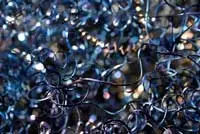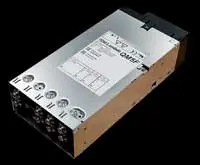Electronics News
Archive : 12 June 2017 год
In a move intended to capture a part of the growing market for voice enabled devices, XMOS has launched the XVF3000 family of voice processors. The parts are said to enable voice capture at distances of 5m or more via arrays of MEMS microphones.
Paul Neil, vp of marketing, noted: “According to Gartner, there will be 500 smart devices in every home by 2025. Today’s solutions don’t scale, so there is a need for a new interface. Because you won’t be able to control these things from a smartphone or tablet, voice is the new click.”
The XVF3000 family is said to feature an updated DSP core to handle ‘heavy lifting’ for speech processing, with additional processing for echo cancellation and beam forming.
While the XVF3000 supports four microphone inputs, the XVF3101 adds keyword recognition. Neil said these devices will be the first in a line of products addressing markets ranging from speakers to industrial applications. Both variants, whic come with 512kbyte of RAM and 2Mbyte of flash, are supplied in 128pin TQFPs.
XMOS has also launched the VocalFusion Speaker development kit, which includes an XVF3000 processor board. Two variants are available: circular, intended for smart speaker applications; and linear, for smart TV and sound bar projects.
Author
Graham Pitcher
Source: www.newelectronics.co.uk
 Rusty stainless steel mesh can be turned into electrodes suitable for potassium-ion batteries, say researchers from the Chinese Academy of sciences and Jilin University.
Rusty stainless steel mesh can be turned into electrodes suitable for potassium-ion batteries, say researchers from the Chinese Academy of sciences and Jilin University.
The research group claims the rust is converted directly into a compact layer with a grid structure that can store potassium ions. A coating of reduced graphite oxide increases the conductivity and stability during charge/discharge cycles.
"Potassium ions are just as inexpensive and readily available as sodium, and potassium ion batteries would be superior from the electric aspect," said researcher Xin-Bo Zhang. "However, the significantly larger radius of the potassium ions has posed a problem. Repeated storage and release of these ions destabilises the materials currently used in electrodes."
The team found that rejected stainless steel mesh from filters and sieves were the best solution. Despite the durability of these grids, harsh conditions do lead to some corrosion. "Their conversion into electrodes could develop into a more ecologically and economically sensible form of recycling," added Zhang.
The corroded mesh is dipped into a solution of potassium ferrocyanide. This dissolves iron, chromium, and nickel ions out of the rust layer. These ions combine with ferricyanide ions in Prussian blue – a dark blue pigment that is deposited onto the surface of the mesh as nanocubes. Potassium ions can easily and rapidly be stored in and released from these structures.
The researchers then use a dip-coating process to deposit a layer of graphene oxide. Subsequent reduction converts the graphene oxide to reduced graphene oxide (RGO), which consists of layers of graphite with isolated oxygen atoms.
"The RGO coating inhibits clumping and detachment of the active material. At the same time, it significantly increases the conductivity and opens ultrafast electron-transport pathways," Zhang explained.
Because the binder-free electrodes are very flexible, they could be highly suitable for use in flexible electronic devices.
Author
Peggy Lee
Source: www.newelectronics.co.uk
 TDK-Lambda has added 700 to 1200W models to the QM series of modular AC/DC power supplies, featuring low acoustic noise and body floating (BF) ready isolation.
TDK-Lambda has added 700 to 1200W models to the QM series of modular AC/DC power supplies, featuring low acoustic noise and body floating (BF) ready isolation.
“The series is narrower by two module slots and offers lower maximum power than the first series released last September,” said Geoff Wilby, general manager at TDK-Lambda UK.
With both medical and industrial safety certifications, the series is suitable for a range of applications, including BF rated medical equipment, test and measurement, broadcast, communications and renewable energy applications.
“Like the last series, QM5 has been subjected to an audible noise test to gauge, not just the frequency, but exactly what the ear hears. A noise can be 45db, but if it’s high frequency, it will have a very annoying high pitch or whine,” marketing manager, Martin Southam, explained.
Packaged in a 127 x 63.3 x 270mm enclosure, the QM models can deliver 1200W at 180 to 264V AC and 700W with an input range of 90 to 264V AC. Up to 12 outputs can be configured using single and dual output modules with voltages from 2.8V to 61.6V.
An optional standby/signal module can be selected with a choice of one or two standby voltages (5V, up to 2A and 12V at 1A), unit inhibit or unit enable, an AC Good signal and a PMBus interface.
“You cannot control the board as you come through the PMBus, so it’s more of an information than a control,” Southam added.
The units operate in temperatures ranging from -20 to 70°C, derating the output power and output current by 2.5% per °C above 50°C. The QM operating efficiency is up to 91% and as internal power loss is reduced, a low speed low audible noise fan can be used.
The units are certified to IEC/EN/UL/CSA 60601-1, ANSI/AAMI ES 60601-1, IEC/EN/UL/CSA 60950-1, is designed to meet IEC/EN 61010-1 and has the CE marking for the Low Voltage and RoHS2 Directives.
The QM series has a maximum earth leakage current of 300µA, while still complying with the EN61000-6-3:2007 and EN60601-1-2:2015 (curve B conducted and radiated) emission standards.The units also meet the EN60601-1-2 and EN61000-6-2 immunity standards.
Author
Peggy Lee
Source: www.newelectronics.co.uk

